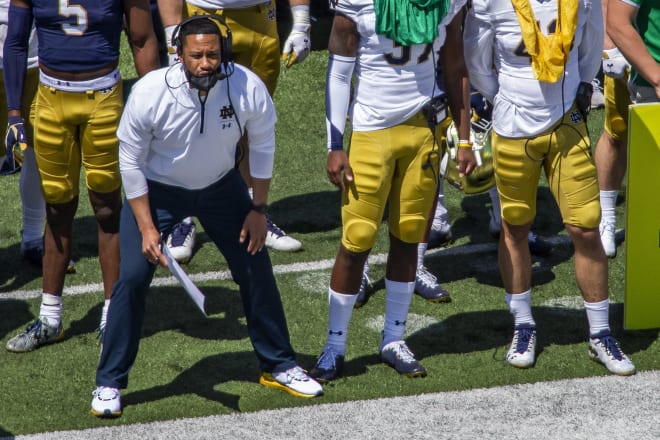Friday Five: Marcus Freeman’s impact on 2022 class shouldn't be understated
The main impact Marcus Freeman could make on Notre Dame’s 2022 class as head coach was retaining it.
Freeman was officially hired Dec. 3, 12 days from signing day. His mission was to convince members of a class that was ranked No. 4 when he took over (and that he helped construct) to stay.
“I was named head coach less than two weeks ago,” Freeman said on signing day. “My thought process was, ‘How do we keep this class together?’”
It was an important task, but the upside of it falls short of the potential impact he could have on 2023 and beyond.
Maintaining the No. 4-ranked class that was already in danger of being leapfrogged leads to, well, the No. 4 class in a best-case scenario. The 2023 class and ones after it give Freeman an entire year to:
• Lead the way on every recruit.
• Win more battles for top-100 recruits (Notre Dame is already engaged in plenty of them).
• Try to put together a surefire top-five class.
The upside differential is clear. But that’s not to say what he did in keeping the 2022 group largely intact is insignificant or unimpressive.
Sure, the finish was sour, with four-star wide receiver CJ Williams backing off his pledge two days before signing day, three-star wide receiver Amorion Walker flipping to Michigan on signing day and four-star cornerback Devin Moore choosing Florida instead of re-committing to the Irish. Those three aren’t write-offs.
Freeman did, though, help reel in four-star offensive guard Billy Schrauth, the nation’s No. 124 overall recruit. Notre Dame had been battling Wisconsin to land him for 18 months. Freeman closed the deal.

The defections should be pointed out, but so should the shaky status of Williams’ and Walker’s commitments before Brian Kelly left. They were flight risks even if he stayed. Freeman, as impressive a recruiter as he is, won’t bat 1.000.
When acknowledging who left, it’s also worth noting those who considered bolting but stayed in part because Freeman helped affirm why they committed in the first place.
USC made a run at four-star linebacker Junior Tuihalamaka. Penn State pushed for four-star offensive tackle Ty Chan to skip the early signing period. Four-star cornerback Jaden Mickey set two official visits after Kelly departed and canceled them. Four-star wide receiver Tobias Merriweather contemplated doing the same. (Merriweather, of course, was also Kelly’s now-infamous last visit as Notre Dame head coach).
That’s four top-200 recruits. Freeman kept them all in the boat.
“To hold onto this class we have in the short period of time, with the landscape of college football changing, was pretty impressive,” recruiting coordinator Mike Elston said.
Freeman wasn’t hired because he could keep relative stability in his first few weeks, but it still is meaningful and affects next year. So far, he’s keeping it. He avoided a mass exodus with the same skill he used to get many of the signees on board in the first place.
“The leadership might be changing,” Freeman said. “Notre Dame is not changing. You committed to Notre Dame because it’s Notre Dame. It was just trying to get these guys to understand, ‘It’s OK, stay committed, let’s sign and you made the right decision.’”
2. Wide receiver
Notre Dame signed one receiver, Merriweather, after Williams and Walker U-turned. He’s an intriguing talent with a rare size, speed and agility mix. He’s also a one-man class in a year Notre Dame needs more.
As it stands, Notre Dame has a maximum of eight scholarship receivers if everyone returns and no one is added. Even if a senior or two heads out and a couple late additions come in, it’ll be a small receiver room next year.
It’s fair to be bummed Freeman couldn’t hold onto Walker and Williams, but blaming him for the whole thing would be excessive.
As stated, he did well hanging onto potential defections. The larger problem is Notre Dame not having a backup plan to act on by Wednesday. Freeman, though, wasn’t involved in receiver recruiting until a couple weeks ago – well after Notre Dame was aware Walker and Williams were exploring other options.
If Freeman targets a few late-period signees and whiffs, it’d be fair to assign him some blame. Same if he and Notre Dame strike out on their top transfer portal options. Regarding Williams and Walker, though, it’s hard to put much on his shoulders. Elston adamantly expressed the same belief.
“It’s not fair to evaluate what Marcus Freeman did over the last few weeks and decide whether he’s going to be the right recruiter for this role,” Elston said.
3. Running back recruiting and Jadarian Price
Before the receiver recruiting restlessness, there was unease about the running back class when Notre Dame failed to land any of its “Big 3” four-star targets: Gavin Sawchuk, Dallan Hayden and Nicholas Singleton.
That mid-summer 0-fer was a one-mile stretch in the marathon that is a recruiting class. (Here’s your reminder that they indeed are marathons, and winning the last mile doesn’t matter if you were middle of the pack in the first 25.2, and vice versa). It was disconcerting at the time because Notre Dame knew it could lose Kyren Williams after this year. Sure enough, Williams is now in the NFL Draft.
A second back was important for numbers, since Notre Dame might have just four scholarship running backs next year.
But after Logan Diggs’ freshman year and 2022 signee Jadarian Price’s standout senior season, it’s hard to see anything resembling a talent deficiency in the backfield. Price is a big-play threat and a strong, tough runner. He’s patient and doesn’t waste motion. He doesn’t have top-end speed, but his open-field acceleration is impressive. He looks like a potential starter and, to me, is one of the Irish’s most underrated signees.
4. NIL and Travis Hunter
No. 1 overall recruit Travis Hunter’s flip from Florida State to FCS Jackson State sure feels like a product of the NIL era.
It’s against NCAA rules for coaches and schools to facilitate NIL deals for recruits and use them as a recruiting tool, but nothing technically stops a team from calling some third-party company interested in sponsoring athletes, working out a deal and having that third party contact the player to set it up if he picks that team.
The NCAA can’t legislate intent and prove such a scenario is a recruiting inducement, even if it smells like one. It also can’t tell a third party what to do with its money. Those were always going to be loopholes in NIL rules. They might make some folks uncomfortable by putting in plain sight what has happened behind the scenes for a while.
But that’s not anywhere close to enough reason to reverse course (not that you can easily put this toothpaste back in the tube) or decry this as the end times.
The NIL era also hammers home that Hunter and tons of other players have value to other entities: schools, coaches, third parties, conferences and so on. That value existed before this year. If it didn’t, there wouldn’t be tales of bag men and bidding wars. At least now the athlete can legally capitalize on it.
5. Don’t be a blip
Beating Kentucky can start a season-saving stretch. It’s not the finish to one, though. One win over a ranked team won’t erase a poor 3-4 start. Notre Dame’s next challenge is to make it the beginning of an extended run and not a fluke by beating Indiana Saturday.
We’ve seen blips from Notre Dame before, like last year’s win over then-No. 11 Florida State in the home finale. Good Kentucky teams have suffered non-conference losses that turned out to be blips for their opponent. Utah and Evansville, for example, defeated the Wildcats in the 2019 non-league slate. The Utes went 7-11 in the Pac-12. Evansville went 0-18 in the Missouri Valley.
Notre Dame cannot afford to be Utah or Evansville.
Indiana (8-2, 1-1 Big Ten) is a veteran team that upgraded its shooting and has an All-American caliber center in Trayce Jackson-Davis. The Hoosiers can go hot and cold on offense and will turn the ball over. Point guard Xavier Johnson is a familiar face from his time at Pitt and fits that ebb-and-flow mold. He makes impressive passes. He’s also prone to some slips in decision-making.
Cracking the Hoosiers’ defense looks like the tougher task. They’re the No. 1 two-point defense, with opponents making just 38.5 percent of those shots. Jackson-Davis is an elite rim protector. They don’t let offenses take 40 minutes' worth of clean looks from deep either.

----
• Learn more about our print and digital publication, Blue & Gold Illustrated.
• Watch our videos and subscribe to our YouTube channel.
• Sign up for Blue & Gold's news alerts and daily newsletter.
• Subscribe to our podcast on Apple Podcasts.
• Follow us on Twitter: @BGINews, @MikeTSinger, @PatrickEngel_, @tbhorka, @GregLadky, and @ToddBurlage.
• Like us on Facebook.



